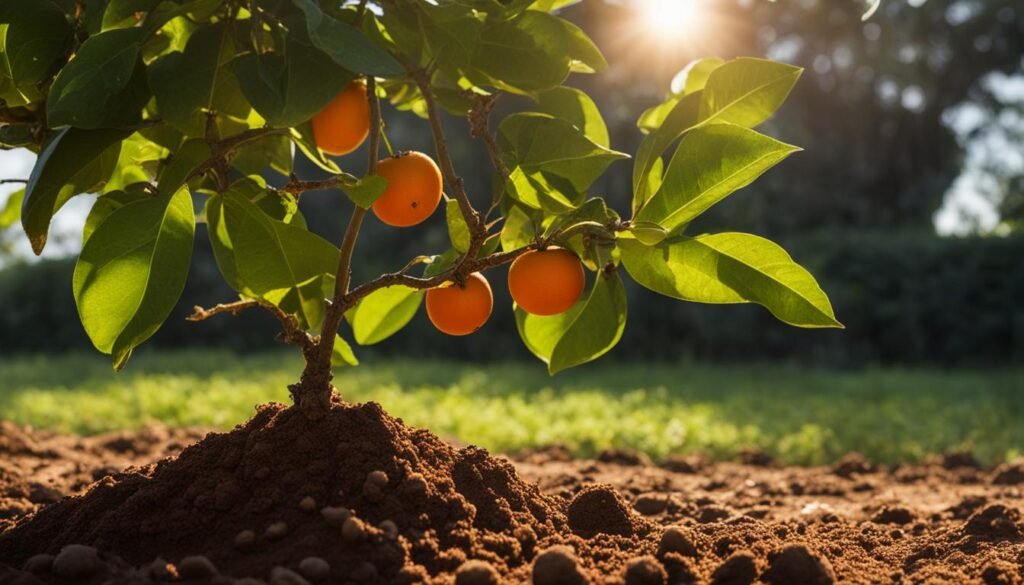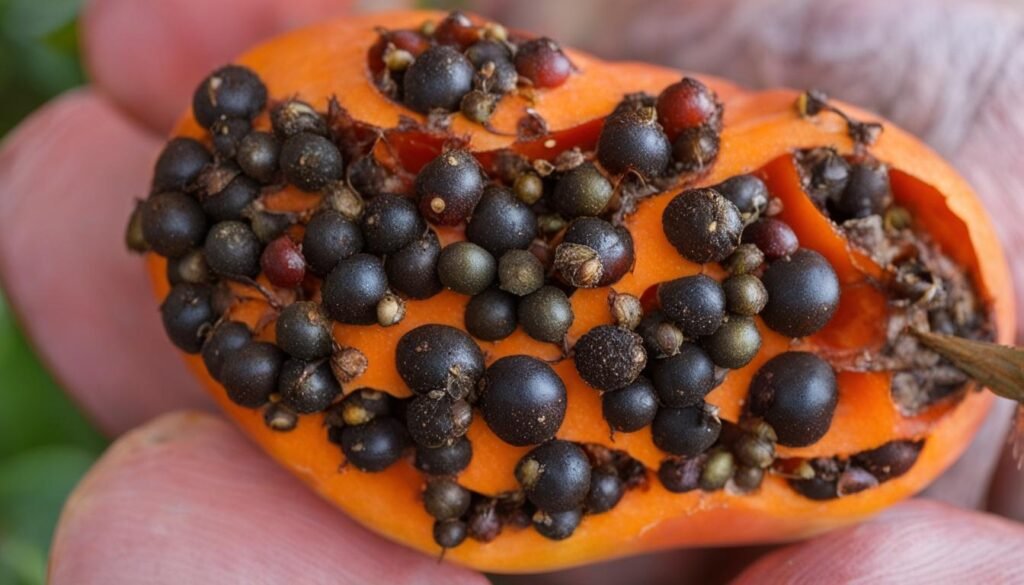Gardening is one of my favorite hobbies, and there’s nothing more satisfying than growing your own fruits. Today, I want to share some valuable persimmon tree gardening tips with you. Whether you’re a seasoned gardener or just starting out, these tips will help you cultivate and care for your persimmon trees, ensuring a bountiful harvest of delicious fruits.
When it comes to planting persimmon trees, choosing the right location is crucial. These trees thrive in well-drained and slightly acidic soil, so find a spot in your yard that meets these conditions. Remember to give them plenty of sunlight or partial shade, depending on your climate. Proper spacing between trees is also important, ranging from 8 to 50 feet apart, depending on the variety you’re planting.
Once you’ve found the perfect spot, make sure to dig a hole large enough to accommodate the root system and position the tree at the same depth as it was in the nursery. Water your newly planted tree deeply to help it establish, but hold off on fertilizing for now. Mulching around the tree will help retain moisture, just be careful not to pile it against the trunk, as that can lead to moisture accumulation and potential damage.
Key Takeaways:
- Choose a well-drained and slightly acidic soil for planting persimmon trees.
- Ensure the trees receive ample sunlight or partial shade.
- Give enough spacing between trees based on the variety.
- Water deeply after planting and avoid fertilizing at this stage.
- Mulch the planting area to retain moisture, but keep it away from the trunk.
Choosing the Right Soil for Persimmon Trees
The success of persimmon tree cultivation depends heavily on choosing the right soil. Ensuring that the soil has the proper pH level and fertility is crucial for the tree’s growth and productivity. Persimmons thrive in slightly acidic soil with a pH level between 6.0 and 7.0. To determine the pH level of your soil, you can use a digital meter or consult your local County Extension Office for soil testing services. If the pH level falls within the desired range, you can proceed with planting. However, if the soil pH is too high or too low, you will need to amend the soil to adjust the pH level.
When amending the soil, it is important to choose the right materials. Organic matter such as compost or well-rotted manure can help improve soil fertility and structure. These amendments should be incorporated into the planting site before planting the persimmon tree. Additionally, adding sulfur or lime can be effective in adjusting the pH level of the soil, depending on whether it needs to be lowered or raised, respectively.

It is important to note that persimmon trees prefer well-drained soil. Poorly drained soil can lead to root rot and other issues. If your soil does not have good drainage, you can consider planting the persimmon tree on a raised bed or mound to improve drainage. This will ensure that excess water does not accumulate around the roots, which can be detrimental to the tree’s health.
Table: Soil pH Levels for Common Persimmon Varieties
| Persimmon Variety | Ideal Soil pH Range |
|---|---|
| American Persimmon | 6.0-7.0 |
| Asian Persimmon | 6.0-7.0 |
| Fuyu Persimmon | 6.5-7.0 |
| Hachiya Persimmon | 6.0-6.5 |
By choosing the right soil and ensuring proper pH levels, you are setting the foundation for healthy and thriving persimmon trees. The right soil conditions will provide the necessary nutrients and conditions for the tree to grow and produce abundant and delicious fruit.
Watering and Mulching Persimmon Trees
Watering is an essential aspect of caring for persimmon trees. Proper watering practices are crucial for the establishment and growth of these fruit-bearing beauties. When it comes to watering persimmon trees, it’s important to strike a balance between providing enough moisture and avoiding overwatering.
After planting a persimmon tree, it’s important to water it deeply to ensure that the water reaches the roots. Adequate watering helps the tree develop a strong root system, which is essential for its long-term health. Once the tree is established, its water requirements may decrease, but it’s still important to monitor the moisture levels, especially during dry periods.

To help retain moisture and suppress weed growth, mulching around the base of the tree is highly recommended. Applying a layer of organic mulch, such as wood chips or straw, helps to conserve moisture in the soil and regulate temperature fluctuations around the tree’s roots. It also acts as a natural weed barrier, reducing competition for nutrients. However, it’s important to keep the mulch a few inches away from the trunk to prevent moisture buildup and potential bark rot.
By following proper watering practices and mulching techniques, you can provide the optimal growing conditions for your persimmon trees and help them thrive. Remember, a well-hydrated and well-mulched persimmon tree is a happy and productive tree!
Pruning Persimmon Trees
Pruning persimmon trees is a vital part of their care and maintenance. Proper pruning helps shape the tree, promotes better fruit production, and ensures its overall health. Here are some essential pruning tips for persimmon trees:
- Prune during the dormant season: Pruning is best done in late winter or early spring when the tree is dormant. This allows the tree to heal quickly and minimizes stress on the tree.
- Remove dead and damaged branches: Start by removing any dead or damaged branches. These branches can be a breeding ground for pests and diseases.
- Eliminate suckers and water sprouts: Suckers and water sprouts are vigorous shoots that emerge from the base or trunk of the tree. Removing them helps maintain an open center structure and directs the tree’s energy towards fruit production.
- Maintain an open center structure: Persimmon trees benefit from an open center structure that allows sunlight to penetrate throughout the tree. This helps promote even fruit ripening and reduces the risk of diseases.
Remember to avoid heavy pruning as it can negatively impact fruit production. Instead, opt for selective pruning to maintain the tree’s shape and size. If you’re unsure about pruning, consult a professional arborist for guidance.
Proper pruning helps shape the tree, promotes better fruit production, and ensures its overall health.
By following these pruning tips, you can keep your persimmon tree healthy and productive, yielding delicious fruits for years to come.

| Benefits of Pruning Persimmon Trees | Key Points |
|---|---|
| Promotes better fruit production | Proper pruning helps redirect the tree’s energy towards fruit production, resulting in larger and more abundant fruits. |
| Improves air circulation | Pruning opens up the canopy, allowing for better air circulation. This reduces the risk of fungal diseases and improves overall tree health. |
| Shapes the tree | With strategic pruning, you can shape the persimmon tree according to your preference, creating a visually appealing and well-maintained tree. |
Harvesting Persimmons at the Right Time
Harvesting persimmons at the right time is crucial to ensure the best flavor and texture of the fruit. When it comes to persimmons, ripeness is key. Unripe persimmons can be extremely astringent and unpleasant to eat. Therefore, it’s important to wait until the persimmons are fully ripe before harvesting them.
To determine if a persimmon is ripe, pay attention to its color. American persimmons turn a deep orange color when they are ripe, while Asian persimmons become fully colored. The color change is a clear indication that the fruit is ready to be harvested. You can also gently squeeze the fruit to check for a soft texture. A ripe persimmon should feel slightly soft to the touch.
When harvesting, it’s important to handle the fruit with care to prevent any damage. Persimmons have delicate skin that can easily bruise or puncture. Using clean and sharp pruning shears or scissors, carefully cut the persimmons from the tree, leaving a small stem attached to the fruit. Avoid pulling or twisting the fruit, as this can cause damage.
Once harvested, persimmons can be enjoyed fresh or used in various culinary creations. From salads to desserts, persimmons add a unique and delicious flavor to any dish. Remember to store your harvested persimmons in a cool and dry place to maintain their freshness and quality.
Now that you know when to harvest persimmons, you can enjoy the sweet and delectable taste of these fruits at their peak ripeness. Harvesting persimmons at the right time ensures a rewarding and satisfying experience for any persimmon tree gardener.
| Persimmon Variety | Color when Ripe | Texture when Ripe |
|---|---|---|
| American Persimmon | Deep orange | Soft |
| Asian Persimmon | Fully colored | Soft |

| Pests | Control Measures |
|---|---|
| Aphids | Use organic insecticides or introduce natural predators like ladybugs or lacewings |
| Scale insects | Remove infested plant parts and apply organic insecticides |
| Mealybugs | Introduce natural predators or use organic insecticides |
| Leaf spot | Practice good sanitation, remove infected leaves, and apply fungicides if necessary |
| Crown gall | Prune infected branches and practice good sanitation |
Persimmon Tree Care Guide
When it comes to caring for mature persimmon trees, there are a few key factors to keep in mind. Regular watering, proper pruning, and mulching are essential for their growth and overall health. Additionally, fertilizing the trees annually in early spring provides them with the necessary nutrients to thrive. Let’s dive deeper into the various aspects of persimmon tree care.
Watering:
Watering is crucial for the establishment and growth of persimmon trees. After planting, it’s important to water the tree deeply to allow the water to reach the roots. As the tree becomes established, it will require less frequent watering, but it’s crucial to monitor moisture levels during dry periods. Adequate water helps develop a strong root system, contributing to the overall health of the tree.
Pruning:
Proper pruning plays a role in shaping persimmon trees and promoting better fruit production. It is recommended to prune persimmon trees during the dormant season, typically in late winter or early spring. Remove any dead or damaged branches, as well as suckers or water sprouts. Maintaining an open center structure allows for better sunlight penetration, which is essential for fruit development. Avoid heavy pruning, as it may reduce the tree’s overall fruit production.
Mulching:
Mulching around the base of the persimmon tree helps retain moisture, suppresses weed growth, and protects the roots from extreme temperature fluctuations. However, it’s important to keep the mulch a few inches away from the trunk to prevent moisture accumulation that can lead to bark rot. Use organic mulch, such as wood chips or straw, and replenish it regularly to maintain its effectiveness.
Fertilizing:
Annual fertilization is key to providing persimmon trees with the necessary nutrients for healthy growth and fruit production. Apply organic fertilizers or slow-release fertilizers in early spring, following the manufacturer’s instructions. These types of fertilizers release nutrients slowly over time, ensuring a consistent supply throughout the growing season. Avoid over-fertilizing, as it can lead to excessive vegetative growth at the expense of fruit production.
Protecting from Extreme Weather:
Persimmon trees are generally hardy, but they can be susceptible to extreme weather conditions. During periods of high heat or frost, it’s important to protect the trees. Shield young trees from intense sunlight using shade cloth or by planting them near taller plants that provide shade. In colder regions, consider wrapping the tree with burlap or using tree shelters to prevent frost damage.

| Key Care Tips for Persimmon Trees | Watering | Pruning | Mulching | Fertilizing | Protection from Extreme Weather |
|---|---|---|---|---|---|
| Frequency | Regular watering during establishment; monitor during dry periods | Prune during the dormant season; remove dead or damaged branches | Mulch around the base, keeping it away from the trunk | Annual fertilization in early spring | Protect from intense heat and frost |
| Benefits | Develops strong root system; essential for growth | Shapes the tree; promotes better fruit production | Retains moisture; suppresses weeds; protects roots | Provides necessary nutrients for healthy growth | Prevents damage from extreme weather conditions |
| Exceptions | Reduce watering once established; monitor during dry periods | Pruning not necessary at planting time | Keep mulch away from trunk to prevent moisture accumulation | Avoid over-fertilizing to prevent excessive vegetative growth | Adjust protection measures based on climatic conditions |
| Additional Tips | Use organic mulch; replenish regularly | Consider using shade cloth or tree shelters |
Troubleshooting Common Issues with Persimmon Trees
If you’re experiencing problems with your persimmon trees, you’re not alone. These fruit-bearing trees can encounter various issues that may affect their health and productivity. In this section, I’ll highlight some common problems and provide guidance on how to address them.
Pest Infestations
Persimmon trees can be susceptible to pests such as aphids, scale insects, and mealybugs. These insects can cause damage to the leaves, fruits, and overall vitality of the tree. To control pest infestations, you can use organic insecticides or introduce natural predators like ladybugs or lacewings that feed on these pests. Regularly inspect your tree for signs of infestation and take appropriate measures if necessary.
Disease Susceptibility
Like any other plant, persimmon trees can fall victim to diseases. Leaf spot and crown gall are common diseases that can affect persimmons. To prevent these diseases, practice proper sanitation by removing fallen leaves and branches from around the tree. If you notice any infected branches, prune them promptly to prevent the spread of the disease. In severe cases, you may need to apply fungicides as recommended by a professional arborist or horticulturist.
Fruit Drop
If you’re finding unripe persimmons dropping from your tree, it could be due to inadequate pollination or insufficient watering. Persimmons require proper pollination to develop fully. To enhance pollination, you can introduce pollinator-friendly plants or encourage bees to visit your garden. Additionally, ensure your tree receives sufficient water, especially during dry periods, to prevent stress-induced fruit drop.
| Problem | Cause | Solution |
|---|---|---|
| Pest Infestations | Aphids, scale insects, or mealybugs | Use organic insecticides or introduce natural predators; regularly inspect and take appropriate measures |
| Disease Susceptibility | Leaf spot or crown gall | Practice proper sanitation, prune infected branches, and apply fungicides if needed |
| Fruit Drop | Inadequate pollination or lack of water | Enhance pollination, ensure sufficient watering during dry periods |
Remember, troubleshooting issues with persimmon trees requires timely action and careful observation. By identifying and addressing these common problems, you can ensure the health and productivity of your persimmon tree, allowing you to enjoy a bountiful harvest year after year.

Conclusion
After following these persimmon tree gardening tips, you can enjoy the beauty and bounty of these delicious fruits in your own backyard. By selecting the right planting site and providing adequate sunlight and well-drained soil, you create the perfect environment for your persimmon tree to thrive.
Remember to water your tree deeply and mulch around it to retain moisture and suppress weeds. Regular pruning during the dormant season will help shape the tree and promote better fruit production. Proper care, including annual fertilization and pest and disease control, will ensure the health and productivity of your persimmon tree.
Lastly, don’t forget to harvest your persimmons when they are fully ripe. The rich, sweet flavor will be worth the wait. I hope these final thoughts on persimmon tree care guide you to a successful and rewarding gardening experience. Happy growing!
FAQ
What kind of soil do persimmon trees prefer?
Persimmons prefer well-drained and slightly acidic soil with a pH level between 6.0-7.0.
Where should I plant my persimmon tree?
Plant persimmon trees in an ideal location where they can receive full sun or partial shade.
How far apart should I space my persimmon trees?
The spacing varies depending on the variety of persimmon tree, ranging from 8-50 feet apart.
How deep should I dig the hole when planting a persimmon tree?
Dig a hole large enough to accommodate the root system and position the tree at the same depth as it was in the nursery row or pot.
When should I prune my persimmon tree?
Prune persimmon trees during the dormant season, typically in late winter or early spring.
How do I know when persimmons are ripe?
Persimmons should be harvested when fully ripe, indicated by a deep orange color for American persimmons and full coloring for Asian persimmons.
What pests and diseases should I watch out for in persimmon trees?
Common pests include aphids, scale insects, and mealybugs, and diseases include leaf spot and crown gall.
How often should I water my persimmon tree?
Water the tree deeply after planting and monitor watering during dry periods. Once established, persimmon trees generally require less watering.
How can I care for my mature persimmon tree?
Regular watering, proper pruning, mulching, fertilizing, and protecting it from extreme weather conditions are essential for the care of mature persimmon trees.
What should I do if my persimmon tree is facing certain issues?
Dropping of unripe fruits, excessive fruit drop, inconsistent fruit size, and leaf discoloration or wilting may indicate issues such as inadequate pollination, stress, nutrient deficiency, or pests and diseases. It is important to identify and address these issues early.




